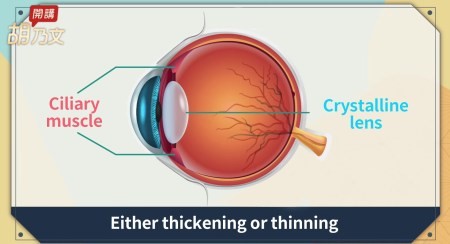Say Goodbye To Blurry Vision
Presbyopia and diplopia are no longer only prevalent among the elderly. Due to the widespread use of electronic devices, eye damage has become increasingly common among younger people.

As the eyes are the windows to the soul, it is essential to take steps to protect them and delay the aging process.
Traditional Chinese medicine (TCM) offers simple yet effective methods to achieve this goal.
Dr. Hu Naiwen, a renowned Chinese medicine practitioner in Taiwan, introduced on his YouTube program, eye training exercises to help prevent and correct presbyopia by moving the eyeballs regularly while reading or browsing the internet.
A study published in Progress in Retinal and Eye Research in 2019 noted that presbyopia is a condition that affects over one billion people globally. The study also revealed that even in developed nations, as many as 34 percent of people over 50 have untreated presbyopia.
Presbyopia, a prevalent eye condition, typically manifests around the age of 45 and worsens progressively, eventually reaching a plateau after age 65.
This ailment’s root cause is part of the natural aging process, whereby the eye’s crystalline lens hardens and loses elasticity, resulting in the inability to focus light accurately on the retina—the light-sensitive tissue layer located at the back of the eye. Consequently, individuals with presbyopia find it challenging to see objects at near distances.
The crystalline lens inside the eye is crucial in focusing on objects. Outside the crystalline body lies the ciliary muscle, which is responsible for altering the shape of the lens. When contracted, the ciliary muscle thickens the lens, enabling clear vision of nearby objects.
Conversely, when relaxed, it makes the lens thinner, making it possible to see objects at a distance. However, in the elderly, the ciliary muscle loses its elasticity, leading to difficulty in contracting and ultimately making it hard to see nearby objects.

Muscles in the eyes work together in a coordinated manner to perform various functions. Some muscles are responsible for controlling the movement of the eye, while others regulate the iris. The transverse muscles facilitate blinking and are under conscious control, whereas the ciliary muscles are involuntary and control the shape of the lens. While the ciliary muscles cannot be controlled by the mind, they can be strengthened through specific exercises that involve looking at distant and nearby objects.
Hu recommends three effective training exercises to strengthen the ciliary and associated eye muscles.
Exercise 1: Alternately focusing on a distant then close object
Hold a pen, or similar object, in front of your eyes and keep your eyes focused on the pen while stretching the arm holding the pen away, then pulling it close, so that the ciliary muscle can be fully trained. Do this repeatedly for a while.
Exercise 2: Keep your eye on the ball
While watching soccer, badminton, or baseball games, intentionally keeping your eye on the ball will cause the eyes to focus farther away, then closer—a very effective way to train the ciliary muscles.
Exercise 3: Repeatedly blinking hard
The many eye muscles are coordinated, and training the blinking and eye rotation muscles makes those muscles stronger. Repeated, hard blinking of the eyes contracts the muscles of the outer eyelid. This exercise will change the pressure inside the eye and make the muscles stronger.
Massage Acupuncture Points To Correct Presbyopia
Acupressure can also be used to treat presbyopia in traditional Chinese medicine (TCM). Regular massage of the parotid acupuncture point in the ear can help slow aging and correct presbyopia. The parotid acupuncture point is located directly behind the external ear canal.
Hu also recommends a prescription called “Di Chi Wan,” which can help treat presbyopia. This prescription consists of a combination of four medicinal plants: raw rehmannia, Chinese asparagus, submature bitter orange, and chrysanthemum, all in equal parts, and made into a pill with honey. Hu also suggests the simpler alternative of making a macerate using five grams of each plant.
Eye Movement To Correct Diplopia
Eye muscle problems can result in diplopia, also known as double vision. Diplopia causes a single object to appear as two distinct images. The condition is further categorized into two types: monocular diplopia and binocular diplopia.
Up-and-down double vision is called vertical diplopia, while left-and-right double vision is called horizontal diplopia. These classifications indicate that the muscles responsible for eye rotation may be functioning improperly.
Improving the situation of diplopia can be achieved through eye movements. A specific training method involves holding a pen or an index finger in front of the eyes and moving it in a pattern of forward, backward, side-to-side, and in circles while focusing the eyes on the object.
This exercise helps retrain the eye muscles and improves their coordination, which can be beneficial when the eye muscles are spastic or overly relaxed. By performing these retraining exercises, the likelihood of experiencing double vision can be significantly reduced.
*Some medicinal plants mentioned in this article may be unfamiliar, but they are generally available in Asian markets.
Note: Because different people have different constitutions, it is recommended to consult your doctor or TCM experts.
yogaesoteric
June 23, 2023
Also available in:
 Français
Français
